#it's not like a fun or enjoyable impersonation; it's like a perfect recording on a device.
Text
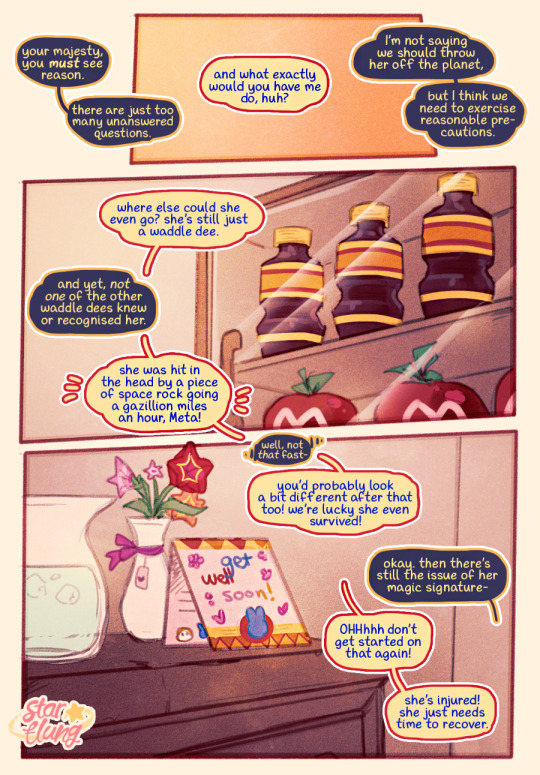
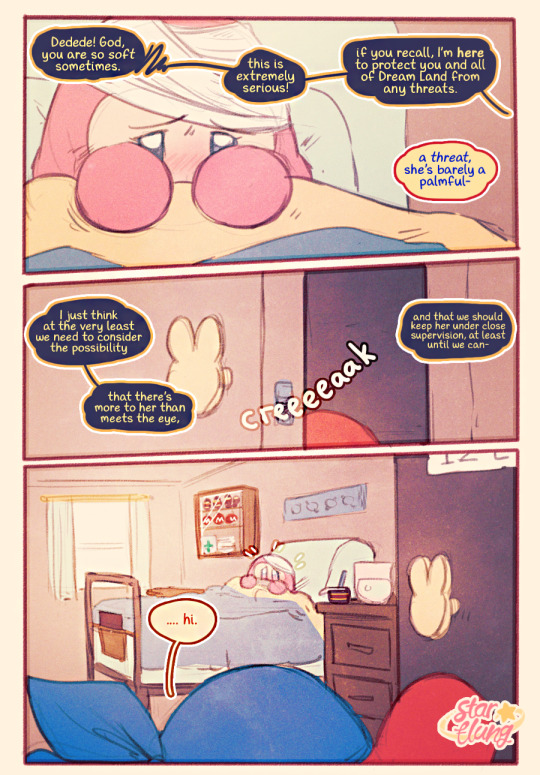

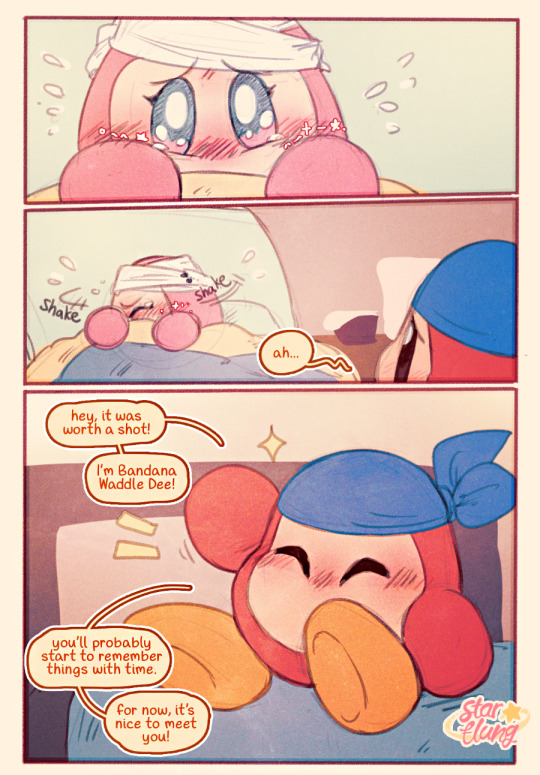


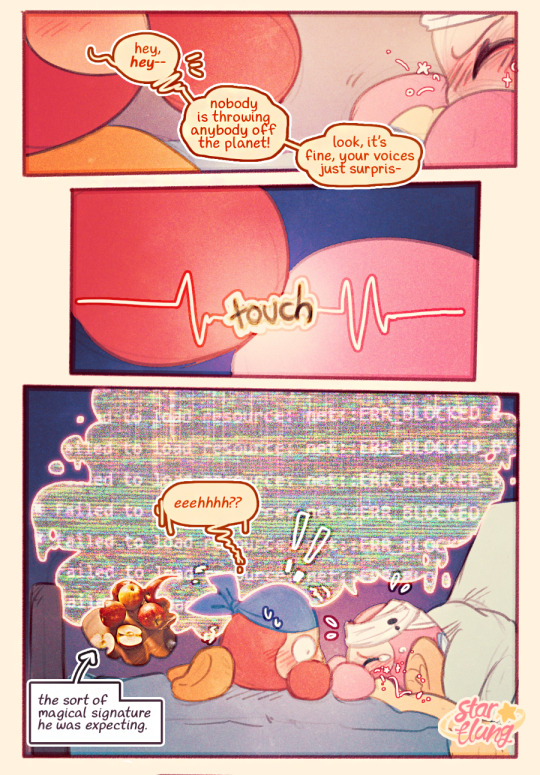

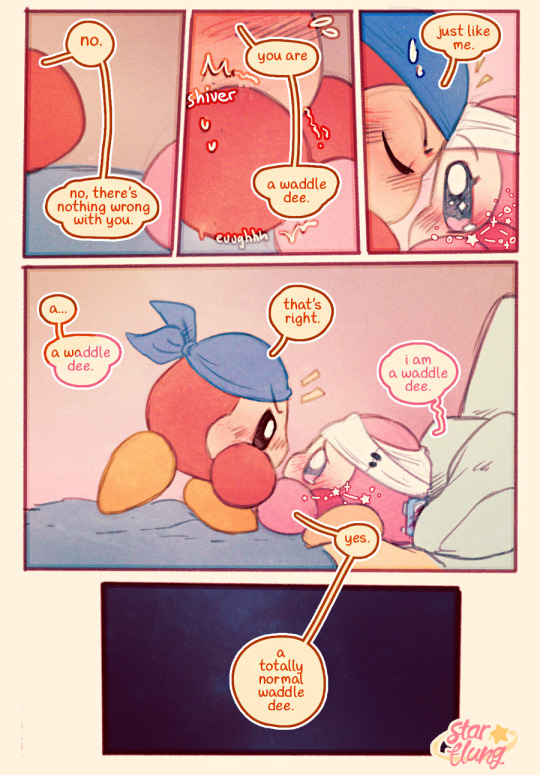

some rather strong first impressions were made.
required reading for the magical "voice" headcanon and another for starstruck's signature in particular. asked by @trainerbob23 !
#did i need to do a 9 page comic for this... well who knows. i had this scene in mind for a long time and wanted to do it justice!#important moment for both of them. you can see starstruck just generating the bandee shaped mental illness in real time.#and bandee resolving to be her point of contact with waddle dees if the others can't handle it#he is after all; the strongest and the bravest and the best of them.#“what is this signature like” it's like meeting something that has a human face but you can tell it is Not Human. think: uncanny valley#it also took her quite some time to pick up her own voice. she could not speak (popstarian) on her own for a while#she does not mimic anymore though if she can help it because it tends to weird others out and she wants to avoid that!!#it's not like a fun or enjoyable impersonation; it's like a perfect recording on a device.#also i guess this is *finally* the reveal of the 'hospital' mentioned previously that folks noticed and also like... her name 😂#anyway.... thank you to everyone who voted for starstruck in that poll and has encouraged this insane self indulgence... wow.#never thought i'd get to draw stuff like this and have others look forward to it. i really hope you'll enjoy this!!!#my art#my comics#starstruck dee#bandana waddle dee
609 notes
·
View notes
Photo

Gender & Pronouns: Cis woman, she/her
Date of Birth: April 17th, 1985 (35)
Place of Birth: Manhattan, New York City, New York
Neighborhood: Ventura
Length of Residency: Since January 2020
Occupation: Co-owner of VP Records Recording Label
Face Claim: Megan Fox
BIOGRAPHY
TRIGGERS: Alcohol, Drugs, Infidelity.
Vivienne was born to Theodore and Malina Stanhope on a rainy Spring morning in Manhattan. Unbeknownst to her, she was born into a very wealthy family. The Stanhope’s family company started in oil and shipping many years ago, but had since evolved into acquiring failing and bankrupt companies and revitalizing them, pushing the Stanhope family into higher and higher socio-economic status.
Her childhood was typical of a rich child. Boarding schools in Europe. Trips around the world. Shopping sprees whenever her mother felt the need. Yet, Vivienne was never interested in those things. She was more interested in the sounds around her, more specifically, music. She had always been sensitive to music. Music was the only way her parents could get her to sleep when she was a baby. It was what stopped the tantrums when she was a toddler. It was what soothed her when she felt feelings she could not express. She heard the violin for the first time on an outing to the orchestra with her parents and grandparents. She was three years old and sat quietly staring into the orchestra pit as they played song after song. She was mesmerized by the sounds it could make and knew she had to learn to play that instrument. As they all piled into the limousine that would take them home, Vivienne could only talk about the violin and how much she wanted to play it. They put her in lessons instantly and she learned the instrument remarkably quickly. She had it mastered by the time she was seven and had composed her first musical piece at the age of nine. The family realized they had a musical prodigy on their hands and trained her with several different tutors and music teachers to encourage this talent within her. She loved her ability to practice music and create it. It became her passion as she grew older.
As she grew, Vivienne learned the viola, cello, bass, piano, and guitar. She is proficient in all string instruments. She was never interested in the harp, but would come back to it every now and again trying to find her enjoyment with it, but it would never come. She became a show pony at her parents’ and grandparents’ parties and events. They pushed her on the stage to play, but she most enjoyed playing for her little sister, Catherine, whenever she could. They did not start off very close as Vivienne was always going away to school, but once they were able to go together, they were inseparable. It was this way until high school started for Catherine. Her family wanted Catherine to complete high school in an American private school in New York so she was whisked away and Vivienne was alone to complete her junior year in her European high school. She had a handful of friends who were musically inclined as well that she enjoyed, but it wasn’t the same as her sister. It would be the following year that Vivienne would be called back to America herself and her life would change.
Catherine was turning fifteen and participating in the debutante ball. She was the apple of their grandmother, Josette’s, eye. They had big plans for the perfect girl so they needed her in America. Catherine was soft, eloquent, gregarious, outgoing, elegant, and mannerly. Vivienne was quiet, observant, curious, reserved, and sarcastic. Catherine was the obvious choice to bring even more recognition to the family name. She was going to be part of a union with another large, wealthy family. The Calloways. The Calloways had an abundance of sons and one of them was Philip. Philip was charming, determined, ambitious, with a bit of edge that they believed Catherine could calm. Their first dates had been at gala tables, where both families sat them next to each other purposely. He was Catherine’s date to her debutante ball. He had escorted her in and caught eyes with Vivienne and the look never faltered. It was instant. Vivienne felt it too, though she tried to avoid him as much as she could. She knew he was not meant for her, but for her sister. However, it turned out, Catherine was not very interested in Philip. He did not move her as he did Vivi. She was glad to have nothing to do with him. Though it surprised the rest of Vivi’s family when he showed up the day after the ball with a bouquet of flowers for the older Stanhope girl.
Vivi and Philip were a bit awkward on their first date. They were quiet until Philip mentioned music and unlocked the key to Vivi’s heart. They spoke for hours about music, losing track of time and having both families wondering and in a panic as to where they were. The days after, they met up and played music for each other. Philip, on his guitar, Vivi on her violin. They fell in love over music. And Vivi knew what she must do. She graduated from her boarding school and applied to Julliard. She earned a full scholarship and majored in music composition and performance. She needed to be in America to be with Philip. He only attended Julliard for one year, before taking his chances on a music competition show and winning the entire thing. It had been a shock, but Vivi knew he would do well. It thrusted Philip into instant stardom and he took Vivi along for the ride. There were concerts, tours, and interviews. Tons of fans screaming his name. Vivi was happy for him, but the hustle and bustle of a famous musician wasn’t something that she felt comfortable with so they agreed that she would stay in New York while he traveled the world with his band.
They spoke pretty much every day and continued to foster their love. Vivi landed a job as a violinist with the New York Symphony after graduation and things were good. On her twenty-third birthday, Philip proposed to Vivienne and she happily accepted. Their families were not thrilled, but they accepted the match, starting to plan a huge wedding that would take over Manhattan for an entire week. Vivi stayed quiet during most of the planning, but Philip could see it was eating her up. She didn’t like being the center of attention without an instrument in her hand and things with the wedding were getting bigger and bigger. After months of cold sweats and nightmares that Philip had to calmly talk her down from, the pair agreed to elope. They took a flight to Vegas and got married by an Elvis impersonator in a Little White Chapel on The Strip. Their families were livid when they saw the wedding on TMZ, but relented that at least they were married and the union was secure.
After a week of a honeymoon on the Calloway family’s private islands, Philip and Vivi were back to their regular lives. Philip was gone on tours and appearances, while Vivi continued in the symphony and waited for him to come back to their Manhattan brownstone. Things did not slow down for Philip until two years later when he had to record another album which brought him home. In the time that he completed his second album, he had also managed to get Vivi pregnant which made their families extremely happy. To everyone’s surprise, Vivi had twin boys, Peyton and Presley, at the age of twenty-eight. Juggling the symphony and twin babies, while Philip went off to promote the album was a bit stressful for Vivi, so she decided to take leave to raise her children and help Philip with his career.
His second album did extremely well and sent him off and away again. Vivi was sad to see him go, but happy that at least his music was successful. But it seemed that fame got to Philip’s head, he began indulging in all the things that were offered to him: sex, drugs, and alcohol. Vivi worried about him as she got frantic early morning calls or could hear girls in the background. Then there were the tabloids where there was video and photo proof of his infidelity. Philip flew home immediately and apologized up and down for his behavior promising that he would not do any of it again. He went to rehab and they went to counseling. They did not want to abandon their marriage and they had young children to think about. Philip convinced Vivi to come on the road with him to promote and tour. She agreed, wanting to keep an eye on him. However, the constant movement of tour life was not conducive to raising two toddler boys. It took a lot out of Vivi so for the second leg, she made the decision to take herself and the boys home. This time, Philip bought them a house in California so it would always be summer and they could have fun. She appreciated it and began to make the California house a home.
Things were going well for a while. They had even embarked on a joint venture, opening VP Records. A recording label that they both owned so they could help other artists and so Vivi wouldn’t miss music so much. It kept them strong and together for a few more years, before it all fell apart again. The cheating, drugs, and alcohol began again. Vivi began visiting Philip randomly to get him to focus and keep him on the right track, but it would not work. On one random trip, Vivi had brought their sons to the penthouse the label had rented for Philip. It was a surprise for their wedding anniversary that she was even there. They called out for him, searching the suite all over until Vivienne found the bedroom. She opened the door to find her husband passed out between two naked women with several bottles of alcohol and drug paraphernalia all around the room. That was the last straw for Vivi. She caught the next flight home and began packing her and the boys’ things to move out and move back to New York. However, she found out she was pregnant and thought again. She confronted her husband and told him about the baby she was carrying. He insisted that he would do better, but she was not a fool again. They separated while she was pregnant and she filed for divorce the day after their daughter, Victoria, was born. The divorce was messy and highly publicized. Yet, Vivienne won primary custody of their children, fifty one percent of VP Records, and half of their assets including the California house. She knew that she could not live there so she sold it and used the money to move to the quiet island of Catalina to rebuild and restart her life with her children.
PERSONALITY
Positive: Musically-inclined | Observant | Resilient
Negative: Sarcastic | Reserved | Cynical
Vivienne Stanhope-Calloway is portrayed by Niki.
3 notes
·
View notes
Video
youtube
NONAME FT. SMINO & SABA - ACE
[6.70]
A Chicago rapper who needs nointroduction...
Julian Axelrod: Three of the best rappers in Chicago the world go in over a bed of whispers, warm breezes and fluttering coos with some of the most conflicted flexes in recent memory. Smino's sidewinder croon hops on and off beat like a kid touching a hot stove before easing into a hook so smooth it practically floats off into the atmosphere. Noname's quietly virtuosic bars gleam with the joy of discovery, a young genius reveling in her new love of weed and sex and the life-affirming act of declaring these other rappers ain't shit. And just when you think it can't get better, Saba comes through with perhaps the crowning achievement of his already incredible year. His motormouth musings elicit some holy mix of pride, elation and astonishment from the depths of my soul, and yet his boasts are so nonchalant it feels like you stumbled into a conversation with the smartest guy at the party."GOAT TRIO TYPE SHIT" is right.
[8]
Matias Taylor: There's a conversational quality to the lyrics, the delivery, and the ebb and flow of the track itself (amplified by the mood-setting acapella sample in the beat). Everything is in sync here; it sounds like the best kind of jam session, or like a late night conversation with good friends -- warm, funny, honest, and never trying too hard to show it.
[8]
Nicholas Donohoue: Luscious, silly, precious, and good-natured. The audio of an early fall drive with your friends commenting on everything out the window, enjoying the laughs and the silence, and holding that feeling that everything will be alright eventually.
[8]
Lilly Gray: Woof, this is smooth. Sometimes minimal, chill work like this ends up sounding empty or missing an element to me, but the pillowy woo background, seeming clipped from a music box or Fantasia, provides soft closeness that keeps it all together. That and the obvious enjoyment of the vocalists (the smile at the end of "wait and just hear me out"), whose complementary textures and flows wind through the scenery without causing more than a ripple. I also have the attention span of a goldfish, so smooth rapping in the same cadence over any length of time can lull me into a state perfect for astral projection or a nap. This isn't ideal for parties or getting work done, but is pretty ideal for laying around daydreaming, floating from voice to voice and thought to thought.
[6]
William John: I went to Noname's Melbourne show about ten days ago. It was a short set -- perhaps 50 minutes in total, including an encore -- and she played only three songs from the newly released Room 25, one of which was added to the setlist spontaneously and put the audience momentarily into the position of a voyeur in the rehearsal room. Despite my caveats, it was an enjoyable show, not least because Noname is one of rap's most charismatic newcomers, and because Telefone, most of which was performed that night, has since its release been one of my favourite gloaming records -- music to play on still, warm nights when dusk stretches long, while downing Negronis as the delights of the dark night grow near. "Ace," too, is attuned to these same circumstances -- a spirited, gorgeous posse cut that belies its drowsy tempo.
[8]
Anna Suiter: Noname's verse cuts off like she's being interrupted. It's clever, but the problem is that Noname barely feels like she's present in the song at all. Even if her verse should be the highlight, it doesn't feel like she's highlighted at all. The general mood of the track doesn't make it easy to pull much out of it either.
[5]
Joshua Minsoo Kim: One's appreciation for Room 25 will directly correspond to their opinion of Noname's spoken word tendencies. As she adopts a more poetic lyricism and delivery, Phoelix's production lays out an open canvas with which she can roam free. One shouldn't confuse the album's neo-soul leanings for objective maturation (lest they be victim to a gullible and untenable rockism), but it does alter the way one interacts with and responds to Noname herself. Such is the stark contrast between Telefone and Room 25 -- both personal, both intimate, but different avenues through which we peer into the Chicago rapper's psyche. "Ace" is the album's most digestible track: standard single length, familiar features, recognizable hook. Frankly, it stands out for being one of her least personal tracks, hindered by a constricting structure that limits her voice's capabilities. Her verse features a competent flow, but it tricks the listener into thinking she's said something particularly noteworthy. Specifically, she relies on a spattering of words that act as signifiers for a vague cool, all of which tumbles into an accidental Chance impersonation in "Room 25 the best album that's coming out." Saba's verse is similarly stiff, bringing the song to a complete halt when he delivers the only line that falls completely flat: "Since I left the road, I got more hits than a deer." Smino's "fuck is you saying?" is incredibly magnetic, but hearing it repeated four times within a single minute only drains it of its energy. All three rappers here have done better, and will continue to do better elsewhere; sometimes, a posse cut isn't conducive to everyone's strengths.
[4]
Maxwell Cavaseno: Dreary faux-gospel/R&B blends as repackaged by James Blake done by people who should know better, and rappers who meander into obnoxious precociousness to the point they sound less like they care about beats and more about backing for a poetry slam. Smino's pinched delivery sounds utterly contrived, Noname's murmury cast-asides act are the work of an ever more sophomoric pseud who can be mercifully less infantile and shrieky than collaborator Chance but likewise is a behemoth of agonizing pretense. Even Saba, usually colorful and capable, sounds fully committed to the youth pastor pap of this record, making it a slog if you happen to be the person for whom self-righteousness, even draped up in faux-humility, is an obnoxious cudgel of tedium.
[2]
Juan F. Carruyo: The main musical leitmotiv -- a multitracked choir singing a jazzy chord progression -- is enough to make me hear this 10 times in a row, but the young guns dropping words on top about what it takes to make it on your own in the music industry these days and how better off they are without any record label providing support is just the D.I.Y. dream come true.
[9]
Jacob Sujin Kuppermann: A few miraculous things about "Ace": (1) the Noname/Smino/Saba/Phoelix (here relegated to just production duty) quartet, two years on from "Shadow Man," still holds together, with an easy and lived-in camaderie. (2) Said quartet, despite the massively increased fame and attention the mid-west psuedo-spoken word rap scene has received since Chance the Rapper's 2016, have not hardened or fallen into the vain self-seriousness that rappers frequently become mired in following breakthroughs. (3) In fact, they're maybe even more fun than before, looser and freer after various sojourns to the West Coast. (4) Even given her guests' best efforts, from Smino's elastic-voiced hook to Saba's double-timed come-up tales, Noname shines as the brightest light in "Ace"'s constellation, weaving together a stream-of-consciousness flow that strings together globalization, weed, vegan food, and Chicago without ever feeling forced.
[9]
[Read, comment and vote on The Singles Jukebox]
2 notes
·
View notes
Text
Best of 2016
2016 is the first year that I have kept something resembling a journal. Back in August, my girlfriend got me a planner for my birthday, and I have written in it almost every day since. It is a calming experience, and has allowed me to take a moment to breathe and remember not only what I must do in the future, but what I have already accomplished.
It is surprising then that I spent very little time documenting my gaming life in that planner. Gaming, as anyone reading this blog might assume, is my most abiding passion, yet I take very little time to think about my gaming time as it relates to my life. I analyze the games I play. I discuss and write about the experience and the design of games, but I do not spend a lot of time considering how it is that games fit into my daily schedule. I sometimes like to pretend that gaming is separate from “real life”. I pretend that the time I spend gaming is somehow less worthy than the time spent out in the world. But it isn’t. It is exactly as worthy as those other times. Looking back through my planner, I have little to no record of what I played this year, what I thought about it, or how these games have factored into my life.
So this year seems as good as any to create my first Game of the Year list. It can be an accounting of what I played, why I played it, and why it meant something to me. Plus, The experience of thinking back on all the games I played this year was cathartic and enlightening. For one, I remembered a lot of games that I played this year that I had all but forgotten about. For two, I got to reconsider each game and think about what it was that made that game interesting to me. What was it that made these games work so well for me when I played them. What did the game do to make me like it so much, and what about the external experience helped it along. I found that a number of games this year stuck out to me so much because of the situations in which I played them.
10) Stellaris

Stellaris is a 4X game, which means I was EXtremely (haha) unlikely to enjoy it as much as I did. This is the first of many games on this list that surprised me in 2016. 4X is a genre of grand strategy game that involves allows players to create empires, and conquer the world through science, military might, or some other form of discovery. Usually, I find these games too impersonal to enjoy. I don’t have a place to sink my emotional anchor. The king of 4X games, the Civilization series, always felt too abstract to me. Playing as an immortal Gandhi negotiating with immortal Genghis Khan felt impersonal. These are not characters, they are avatars for a nation. What Stellaris does differently is offer a narrative to go along with its grand strategy. Not that it has a pre-written story Instead, as you play through the game, it does a fantastic job of developing a unique story for your alien empire. At the beginning of the game, players create a species both biologically and politically. Then, they take this species through their conquest of the stars. Throughout the experience, new leaders will rise and fall, time will pass, and events and characters will rise from the ranks of the randomly generated denizens of the player’s alien empire.
To help me create these narratives, I also brought in a ringer: a good friend from high school. We sat and played Stellaris for hours earlier this year. He was leaving town for grad school, and the two of us had always played games together. Sometimes cooperatively, sometimes competitively, or sometimes we would play two different games in the same room. Stelllaris is the perfect game for that over the shoulder play, with both of us making decisions about the direction that our peaceful space mushroomms would take in their quest to conquer the galaxy through negotiation and friendship. Stellaris found its place on this list because it gave me a reason to look at 4X games, and gave me a chance to hang out with a good friend and tell wonderful stories.
9) SUPERHOT

I played the browser-based demo of SUPERHOT all those years ago (I think it was like, 2) and wished for more immediately. Recently, I got my wish. The full SUPERHOT experience is simply fantastic. In SUPERHOT, time only moves when you move, making for a stylish bullet time experience. The only reason this game is not higher on my list is that I haven’t finished it yet. This is the flip side of seeing how games relate to my life: sometimes events in my life make my gaming experiences better, and other times my life gets in the way of my full enjoyment of a game. I love SUPERHOT, but other games and a busy schedule have kept me from tearing all the way through it. What I have gone through so far has excited me.
8) Darkest Dungeon
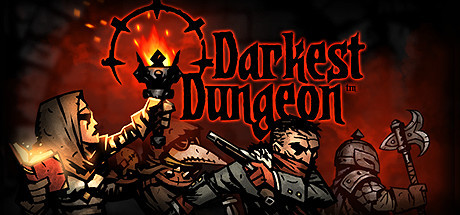
Darkest Dungeon is a game that I spent a decent amount of time with before 2016. The strange pattern of modern game releases means that some games are functionally out long before they are technically out, and I spent a lot of time with this game in Early Access. Darkest Dungeon is a disaster factory. As you lead your band of merry adventurers into the various randomly generated dungeons on offer, they will proceed to get less and less merry. Exposed to various horrors both Gothic and eldritch, your characters will pick up maladies that hinder their ability to function. Normally, I don’t like these kinds of games. Getting screwed over always makes me feel like I need to restart the game to try and get a better run. Darkest Dungeon is so cruel that all notions of having a clean run go out the window. Characters will go insane, they will turn on each other, and they will die. Once I accepted that, I began to have a great time with Darkest Dungeon, and despite its cruelty, the game feels fair. I can mitigate the horrible circumstances that befall my characters using good tactics, and the party building and moment to moment combat feel so satisfying and deep. I have a run going now where I name every character after friends of mine, and picking up this game for an hour or so every couple of days has been a great way to experience its horrible, horrible journey.
7) Overwatch

I thought I would hate Overwatch. Its MOBA trappings, and its competitive nature worried me at first. I am not a big fan of MOBAs, and I don’t usually find the time to put into competitive games, but Overwatch played with both of those ideas in a way that allowed me to dive into the experience. For one, aside from the skills that each character has, the game bears no resemblance to a MOBA. As far as the competitive side goes, Overwatch made me feel competitive without feeling like I sucked. The characters played differently enough that I could find a niche to fill in any game, and I enjoyed it enough to get good at it. Combine that with forgiving hit boxes and a community that genuinely seemed to be there for a good time, and Overwatch successfully dragged me into the competitive shooter scene for a time. It also helped me to make my first friends online. I played a lot of Overwatch with a friend of mine that I game with regularly, and he introduced me to a whole crew of people that played Overwatch practically every night. It fell by the wayside when other games I wanted to play more came out, but it has a special place in my heart.
6) DOOM

What is there to say about DOOM that has not already been said? It is just a fantastic shooter from top to bottom. It modernizes a classic without losing the soul of the original experience, and provides one of the most exciting shooter campaigns I have ever experienced. Also goddamn. A shooter with good shotguns in it. Oh man. I could not be happier with that.
5) Tilt Brush

Virtual Reality may not be “here” quite yet, but I am having a blast with it. When the VR headsets first hit the markets earlier this year, I was excited to see what they could offer and to see where the technology would go, but I had no interest in picking up a headset for myself. As the year wore on and I saw more and more VR experiences come out, I became increasingly excited about the platform, and after seeing some footage of Tilt Brush, an idea started to form. I called my dad, and we decided to go in halfsies on a Vive, and set it up somewhere we could both play with it. Day one of using the headset, and I had the same experience that everyone has seemed to have with VR: I was giddy, and excited about doing even the most simple tasks. That excited me, but what really got me about the potential of the system, was watching my dad play with it. A few years ago, I convinced him to play Journey as a birthday present to me. We spent almost three hours working through the game, and he loved the experience. The controls hindered him though. Controlling a character in 3D space is hard for a person who has never played a video game. VR solved that problem. Within minutes he was through the tutorial and painting in Tilt Brush. I have never seen a gaming experience so thoroughly enrapture a non-gamer. Not the Wii, not the rise of cell phone games, and not even the story games like Journey that I love so much. Google’s Tilt Brush has been the standout experience for my family. My dad is an artist, and Tilt Brush has brought him into giggling fits a number of times. Seeing someone who struggled through Journey with me have such an intuitive and fun experience with Tilt Brush has convinced me that virtual reality, in whatever form it takes, is going to be a lasting and encompassing experience in the years to come.
4) Brigador
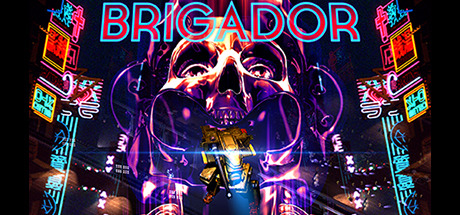
Brigador gets the award for my favorite game of 2016 that most of my play time is logged in 2015. I played a lot of this game in Early Access, and the experience has only improved with Brigador’s official release. For those not in the know, Brigador is an isometric mech action game billed as a “Kool-Aide Man simulator” by its creators because of the characters’ propensity for smashing through walls. Brigador is a challenging game, at least in part due to its controls. Each type of vehicle controls differently, and the game’s combat requires constant awareness of positioning, facing, and aim. Stealth ends up being a surprisingly viable option, making smashing through walls like the Kool-Aid man to surprise enemies a critical strategy. Most enemies can be dispatched with ease if they are not prepared to take you on, but concentrated fire can shred even the toughest of tanks. It is a fantastic experience: tactical, stylish, satisfying, and all backed with some of the best gritty mech fiction I have read in a long time. Also, the soundtrack rules.
3) Monster Hunter Generations
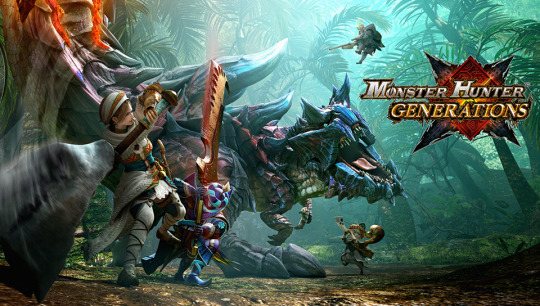
Look, I just really like Monster Hunter. It is a series that has lived on incremental improvements, repeated monsters, and repeated maps, but with Generations, Capcom took a few exciting steps forward. The addition of Styles, and Hunter Arts has broadened the hunting experience. The weapons feel alive and exciting, and the fights have lost none of the edge. At least for me. A lot of people on the internet claim this game is a lot easier than previous entries, but I suppose I am not good enough at the games to make that call, because I still feel challenged. Either way, in this game I have used more weapons, fought more monsters, and all before high rank. Also, I got to go to the official Capcom Monster Hunter meetup in San Francisco last month, and it ruled. Meeting so many people as excited about the series as I am, and getting to hunt with total strangers rekindled my love of the series, and definitely contributed to this game placing so highly on this list. Plus, I won a Tigrex statue in a raffle by completing in game challenges, and that felt pretty good.
2) Titanfall 2

Titanfall 2 is my favorite multiplayer shooter. This is a major endorsement given that this year also saw the release of Overwatch, one of the most elegantly designed games I have ever played. I never got into the Left Trigger, Right Trigger shooter genre. Call of Duty 2 and Call of Duty 4 both pulled me in with their excellent single player campaigns, but I bounced off of the multiplayer modes for those games. It felt like I could not defend myself from attack in those games, and I did not have the speed on the triggers that I needed in order to do well. Titanfall 2 has alleviated those problems for me. For one, the Titans allow for a slower pace of play from the Pilot combat. In a Titan, I can survive an incredible amount of damage, and take down waves of NPC enemies and human-controlled Pilots. With the battery system, I can even remain in my Titan indefinitely with a supportive team. Pilot combat is where the game shows how it has solved the problems I had with more traditional Left Trigger, Right Trigger shooters: in Titanfall 2, I can outrun bullets. In the Call of Duty games, once an opponent has gotten me in their sights, I have no chance of escaping. Maybe I can get a lucky headshot in and survive their attack, but most likely I would just get gunned down. In Titanfall 2, I can get moving so quickly, that I can get out of an enemy’s cross-hairs, outmaneuver them, and take them down. It is a major change to the genre that gives me a feeling of agency that none of its competitors ever have. Also, the single player campaign seems great. I have only gotten through a couple missions in it because the mulitplayer keeps drawing me in.
GAME OF THE YEAR: Stardew Valley

Not since Journey have I been so surprised by a game. When I first saw Stardew Valley so highly recommended by Dan Ryckert of one Giant Bomb dot com, I expected a cutsey game that would be fun to while away some time with. What I did not expect was to fall so head over heels in love with a fictional town and its pixelated inhabitants. Stardew Valley delivers an experience that is at once free and constrained, relaxing and stressful. While at first glance, it seems like a simple farming simulator, you can only work for so long on your farm in a given day. This forces you out into the town where you find a town filled with well written characters and some truly interesting mysteries. From skeleton arcade cabinets, to monster filled mines, to broken bridges, and a wizard’s tower, the town of Stardew Valley is littered with tantalizing secrets. It is also the game that taught me to let go of some of my desire for efficiency in gaming. Whenever I play games, I feel badly if I perform less than optimally. This used to mean that I spent hours repeating sections and levels, missing huge chunks of games that I never finished because I burned out trying to nail that perfect run from the get go. Stardew Valley is a game that initially seems like an optimizers’ nightmare: every day is limited by your character’s Energy as well as time, and there are so many things to do that someone trying to nail an optimal pattern would probably never make it past the first day. So, I had to let go. Fitting that a game about breaking out of a schedule and enjoying the simple things taught me not to worry so much about its schedule. Stardew Valley became something I returned to daily, both for short trips and for multi-hour sessions, and it never left me feeling bored. It is one of the most soothing games I have played in years, and I am always excited to boot it up and see what else I can turn up in the valley.
2016′s Not 2016 Game of the Year
Dark Souls

This year, I began listening to the Bonfireside Chats podcast. It is a podcast that takes a deep look at all of From Software’s Souls games, from Demon’s Souls to Bloodborne. I played Demon’s Souls when it first came out, and though I learned to respect its tough but fair attitude, I eventually moved on to other games, and never finished it. When Dark Souls came out, I bought it for the Playstation 3, and played through a solid chunk of it. Unfortunately, after taking down the Gargoyles that guard the Undead Parish bell, I got lost. I had no idea where to go next, and spent so many hours wandering aimlessly, that I gave up on the game. About a year later, a friend of mine got into Dark Souls on the Xbox 360, so I picked up a used copy and embarked on my journey again. This time, I found the door that I needed to unlock after the gargoyles, made it all of the way through Ornstein and Smough in Anor Londo, and then just kind of stopped. The slow pace of play and the slew of new games coming out eventually drew me away. In 2015 I played through Bloodborne, and actually beat it. I had a free week with no work, and the faster pace of the game allowed me to drive through to the end.
Fast forward to now, and the Bonefireside Chats podcast inspired me to dive back into the Souls side of the series and rediscover what makes it so good. I bought all three Dark Souls games on PC, and began my journey.
As of now, I am deeper into Dark Souls than I have ever been, and I am having a blast. Knowing so much more about the game, but also getting to rediscover that feeling of finding a new area and not knowing what to do with it are so exciting. The deliberate combat and tough but fair challenges really cannot be had anywhere else. If nothing else, Dark Souls is a master class in level design, and something that should not be missed by any game developer.
#gaming#games#game of the year#goty#stellaris#superhot#tilt brush#vive#darkest dungeon#overwatch#doom#titanfall 2#brigador#monster hunter generations#monster hunter#dark souls#stardew valley
4 notes
·
View notes
Text
Hyperallergic: Twelve Reasons Why the Chainsmokers Are Failing at Love
As the most infamous and possibly the most successful new group in America, the Chainsmokers offer a clear lesson in how white men can remain relevant in an increasingly diversified pop landscape: through self-erasure. The EDM duo’s chart hits throughout 2016, leading up to “Closer,” the monster earworm that spent most of last fall atop the Billboard Hot 100, epitomized a widespread practice in which often male DJs hire often female singers to lend their tracks content and charisma. Tracks such as “Rozes,” “Don’t Let Me Down,” and “All We Know” inhabit an established corporate style sufficiently, slickly, and anonymously. The electronic surface is so smooth that the perky plaints of singers like Daya and Phoebe Ryan disappear right into it. Adherence to the broadest of EDM pop conventions functions less as selling point than admittance badge; pretty polish, aching melodies, drops that sway rather than crunch — voila, songs perfect for filling dead space on the radio, even if they suggest only a generalized style without approaching a particular one. Such is the appeal of the blank slate. As for “Closer” itself, its chart success appears to have convinced the Chainsmokers, at heart studious entrepreneurs on the lookout for statistical affirmation, that they’d found the paradigm for their subsequent career. Their full-length debut, Memories… Do Not Open, out since April, lives in the shadow of their greatest hit.
As public figures, the Chainsmokers fascinate in their odd disparity between art and persona. Andrew Taggart (the cute one) and Alex Pall (the smart one) give interviews to Billboard and Rolling Stone where they strike various absurd poses for the camera, including one marvelous shot in Billboard in which they stand waist-deep in a pool in their t-shirts and jeans, holding glasses of beer while spouting quasi-parodic approximations of so-called locker room talk that I won’t quote here, so as not to upset delicate sensibilities. They present themselves as pop radio’s very own “tech bros,” as Billboard’s Chris Martins puts it, covertly sincere young men who party hard and spend too much money on luxury goods while working obsessively to refine their business model.
But their hits, unobtrusive as dance songs and nebulous as love songs, could have been generated by any artist, or algorithm, with any persona, in any state of mind; what they lack, at the very least, is a spirit of enjoyment that one expects from nominal party animals. Sleek nullities like “Rozes” and “Don’t Let Me Down” exist in a referent-free vacuum: bland genericism can’t be reliably traced back to the lab that engineered it. Perhaps one might look for fingerprints in the reflection of the synthesizer polish, but these songs are purposefully anonymous — the sung chorus’s subservience to the instrumental drop decentralizes the singer, while midtempo caution and mildly glowing synth textures decentralize the drop. As for the elusive, centered subject — the Chainsmokers themselves — they’re gone, their presence hardly evident in the songs at hand. Even when Taggart takes the mic, he’s such a nothing singer that he fails to evince even the slightest hint of personality. They’ve established a brand through public relations; their music needn’t follow suit.
Their breakthrough hit, which is also their only fabulous song, 2014’s “#Selfie,” stands as an anomaly in their catalog for its energetically abrasive beat and spoken vocals. Over spritzy, crunchy, percussive synthesizer bounce, a delightfully narcissistic young woman played by Alexis Killacam recites a monologue consisting of exaggerated stereotypes meant to indicate the shallowness of clubgoers, California girls, or both: “After we go to the bathroom, can we go smoke a cigarette? I really need one. But first, let me take a selfie.” Whatever their intentions (who cares?), and however immature and/or sexist the song may be, it reads as a love letter — adolescent boys mocking adolescent girls to mask jealousy and admiration. Behold Frank Zappa’s clumsily cruel “Valley Girl” done with love. However tiresome her bubbly cadence, the details of her life do sound like fun: dancing in the club, drinking with friends, and eventually going home with her crush. The song projects not scorn but rather an amusing defense of clubgoers, dance music, and a species of shallowness that may also be a species of fun. At the time, the song was misread as merely contemptuous of its subject and dismissed as a novelty single by critics who didn’t understand that such a categorization needn’t amount to dismissal. Then the Chainsmokers stuck around, longer than most artists behind so-called novelty singles. Their subsequent series of increasingly dull hits, exercises in crafted electronica whose glistening keyboard whooshes and muted hooks ostensibly stand in for eroticism (in “Rozes” especially), functioned as a solemn corrective to the frivolity of “#Selfie.” Then came “Closer”, Andrew Taggart’s first time as a singer in a duet alongside guest star Halsey, and their career trajectory, along with modern romance itself, was forever changed.
The dirty little secret behind “Closer” is that the insufferable ex Taggart can’t help repeatedly crawling back to symbolizes hookup culture itself. Don’t believe the literal reading that the song concerns two people. Taggart, whose mild croak renders him an everyman figure, and Halsey, whose fuller, more enthusiastic cry tastes like liquid sugar by comparison, meet in a hotel bar and rekindle the flame of days past, while a feelgood keyboard hook occupying the drop position sets a defiantly celebratory tone. The repeated proclamation “We ain’t ever getting older” might have been a slogan of fist-pumping triumph, but there’s a melancholy to it, for to never get older means to never mature, which means to never find your one true love and settle down. A whole generation of young people’s anxieties about intimacy, casual sex, and commitment informs “Closer,” to the extent that it fails to parse if Taggart and Halsey are viewed as individuals: the song’s hysteria exists on a scale too grand for one couple. Rather, “Closer” concerns an endless hookup cycle that doesn’t satisfy but keeps beckoning because breaking the cycle is hard and the alternative, prolonged intimacy, is scary. The pretty hook offers nominal catharsis, but it’s bittersweet; to pump one’s fist during the drop in “Closer” is to acknowledge one’s erotic life as frustrating, impersonal, scripted, and insufficient. If the platitude about millennials participating in casual sex while secretly hating it holds any truth, then Taggart and Halsey are its avatars, standing in for whole generational attitudes; as singers they scream past each other and fail to connect, doomed to fuck a repetitively steady stream of anonymous ciphers for the rest of eternity.
Likewise, Memories… Do Not Open articulates the romantic anxieties that supposedly plague affluent, heterosexual millennials, and perhaps fratboys most of all. “Break Up Every Night,” in which Taggart “don’t wanna wait until she finally decides to feel it” so he “build[s] the bridges up again,” sums up an album whose midtempo electroballads affirm every idiotic cliché about young people, technology, social media, narcissism, casual substance use, casual sex, and the collapse of traditional dating — it’s as if Andrew Taggart and Alex Pall have read every incoherent thinkpiece on the internet about their own generation and internalized said thinkpieces in a weird ritual of guilt and self-hate. Imagine one of those plaintive and/or smug Odyssey listicles explaining Twelve Reasons Why Millennials are Failing at Love, translated into its album equivalent. Look, I’ll write that listicle now:
1. We’re scared to settle down (“The One”).
2. We’re individualistic and goal-driven, at the expense of our partners’ needs (“Break Up Every Night”).
3. We party too much and do too many drugs (“Bloodstream”).
4. Wealth and access to technology makes many of us egocentric, and that means we’re insensitive toward our partners and their needs (“Don’t Say”).
5. We hold out for too long, because we grew up watching Disney and superhero movies and have unrealistic expectations (“Something Just Like This”).
6. We’re scared to define our relationships past the casual stage (“My Type”).
7. Sex with strangers becomes routinized (“It Won’t Kill Ya”).
8. We care about our image on social media more than we care about real relationships (“Paris”).
9. We can’t commit to one person (“Honest”).
10. We’re materialistic and brand-conscious (“Wake Up Alone”).
11. We make excuses to avoid dealing with our feelings (“Young”).
12. We have a horrible weakness for triumphalist sentimentality and EDM power ballads that diagnose our perceived generational maladies (“Last Day Alive,” also the whole record).
Whether or not these spurious criticisms apply — to individuals? to a whole generation? meaning whom? maybe just the Chainsmokers? or their fans? — they make for a tedious, self-defeating album, dotted with songs that keep fussing over their own failure to have a good time. “Break Up Every Night” spirals around glowing, percussive synth stabs with winning energy, while “It Won’t Kill Ya” sways alluringly over cautious piano chords during the verses and woozy airhorn during the drop, but mostly even the upbeat songs go through the motions on autopilot. Perhaps juicier beats would do the trick, but the Chainsmokers’ brand of EDM softcore, lightweight keyboard yearning in processed pastel shades, produces drab ear candy with sickly clumps of sugar inappropriately concentrated in single spots. Strummed guitars and plucked pianos are integrated smoothly and hardly make a difference. Nor, paradoxically, does the thematic focus relieve their anonymity. Working squarely within the guidelines of current radio convention and consequently confining themselves within a tighter box than is actually necessary to achieve airplay, these are punishingly generic songs, perhaps because speaking for a whole generation involves the widening and hence blurring of one’s scope. Taggart’s eagerly clumsy drawl and Emily Warren’s smoky croon suggest roles too composite to reveal any character of their own; Coldplay’s Chris Martin on “Something Just Like This,” while intolerably sincere in much the same way, at least sounds like himself. To further dilute the record, they don’t even include “Closer,” leaving the hookless “Paris” and the honorably, expediently soaring “Something Just Like This” to remind listeners that yes, indeed, they are a frequent radio presence.
Memories… Do Not Open would be an object lesson in the perils of universality and the blank slate, if it hadn’t topped the Billboard 200. Positive market feedback ensures the production of more music like this in the future. Taggart and Pall hold up a distorted mirror to their audience, showing fans the ugliest versions of themselves. I wish American consumers didn’t identify, as they say.
Memories…Do Not Open (2017) and Closer (2016) are available from Amazon and other online retailers.
The post Twelve Reasons Why the Chainsmokers Are Failing at Love appeared first on Hyperallergic.
from Hyperallergic http://ift.tt/2rrYQnc
via IFTTT
0 notes